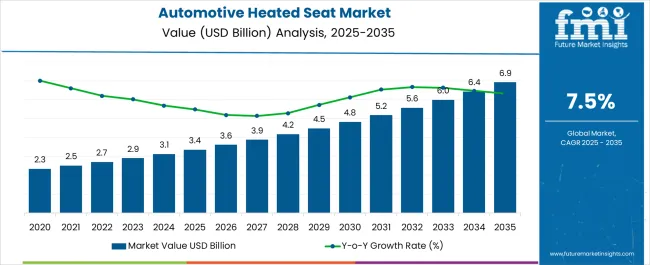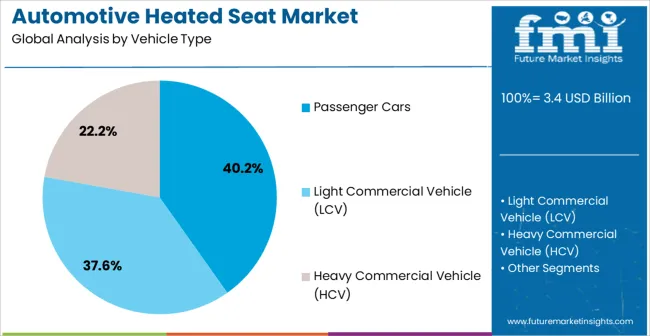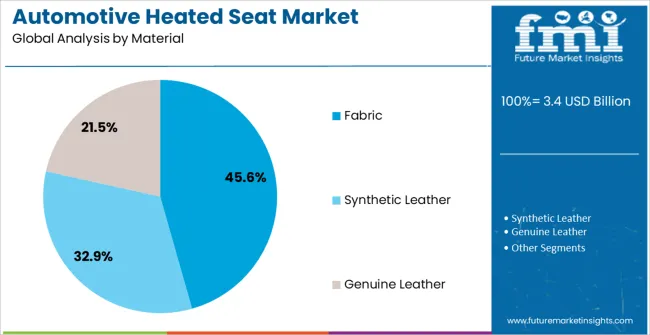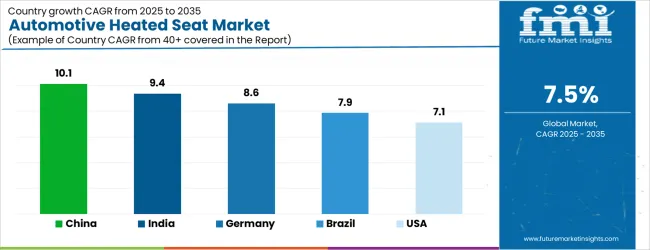The Automotive Heated Seat Market is estimated to be valued at USD 3.4 billion in 2025 and is projected to reach USD 6.9 billion by 2035, registering a compound annual growth rate (CAGR) of 7.5% over the forecast period.

| Metric | Value |
|---|---|
| Automotive Heated Seat Market Estimated Value in (2025 E) | USD 3.4 billion |
| Automotive Heated Seat Market Forecast Value in (2035 F) | USD 6.9 billion |
| Forecast CAGR (2025 to 2035) | 7.5% |
The Automotive Heated Seat market is experiencing steady growth, driven by the increasing demand for comfort and premium features in vehicles across passenger and commercial segments. Rising consumer expectations for enhanced in-car experiences, particularly in regions with colder climates, are fueling adoption. Integration of heated seat systems contributes to improved occupant comfort and supports the overall vehicle value proposition, which is becoming a key differentiator for manufacturers.
Technological advancements, including energy-efficient heating elements, smart climate control integration, and lightweight design materials, are enhancing performance while minimizing power consumption. Strong demand from original equipment manufacturers for factory-fitted premium features is further driving market expansion. The trend of personalization and vehicle customization is also encouraging adoption across passenger cars and luxury vehicle segments.
Investments in research and development to improve safety, durability, and ergonomic design of heated seat systems are supporting long-term market growth As vehicle manufacturers increasingly focus on enhancing passenger comfort and safety, the Automotive Heated Seat market is poised for sustained expansion over the forecast period.
The automotive heated seat market is segmented by vehicle type, sales channel, material, and geographic regions. By vehicle type, automotive heated seat market is divided into Passenger Cars, Light Commercial Vehicle (LCV), and Heavy Commercial Vehicle (HCV). In terms of sales channel, automotive heated seat market is classified into Original Equipment Manufacturer (OEM) and Aftermarket. Based on material, automotive heated seat market is segmented into Fabric, Synthetic Leather, and Genuine Leather. Regionally, the automotive heated seat industry is classified into North America, Latin America, Western Europe, Eastern Europe, Balkan & Baltic Countries, Russia & Belarus, Central Asia, East Asia, South Asia & Pacific, and the Middle East & Africa.

The passenger cars segment is projected to hold 40.2% of the market revenue in 2025, establishing it as the leading vehicle type. Growth in this segment is being driven by rising consumer preference for comfort-enhancing features in everyday vehicles. Heated seats provide ergonomic support and temperature control, improving passenger satisfaction and perceived vehicle quality.
Manufacturers are increasingly offering heated seats as standard or optional features in mid-range and premium vehicles to enhance competitive positioning. Integration with advanced vehicle systems, such as climate control and seat memory functions, further strengthens adoption. Passenger cars, being the largest volume segment in global automotive production, offer significant opportunities for heated seat penetration.
Continuous innovation in energy-efficient heating materials, smart sensors, and automated temperature adjustment is reinforcing the segment’s leadership As automotive manufacturers seek to differentiate their offerings and meet consumer demand for comfort and convenience, heated seats are expected to remain a critical feature, sustaining strong growth in passenger cars.

The original equipment manufacturer (OEM) sales channel segment is expected to account for 52.7% of the market revenue in 2025, making it the leading sales channel. Adoption is being driven by the increasing demand for factory-installed heated seat systems that ensure seamless integration, reliability, and compliance with vehicle safety standards. OEM-installed systems benefit from high-quality components, standardized design specifications, and warranty-backed assurance, making them preferable for both manufacturers and consumers.
Strong collaboration between automotive suppliers and OEMs enables efficient production, timely delivery, and incorporation of the latest technology. Increasing focus on vehicle personalization and comfort features is further reinforcing adoption through OEM channels.
Additionally, OEM integration reduces post-sale installation complexity and ensures compatibility with in-vehicle electronics As automotive manufacturers prioritize premium features and customer satisfaction, the OEM sales channel is expected to continue leading the market, supported by the growing preference for factory-fitted heated seat solutions.

The fabric material segment is projected to hold 45.6% of the market revenue in 2025, establishing it as the leading material category. Growth is driven by its comfort, breathability, and cost-effectiveness, which make it suitable for a wide range of passenger vehicles. Fabric heated seats provide an optimal balance between temperature control and tactile comfort, enhancing passenger experience in different climate conditions.
The adaptability of fabric to advanced heating elements and insulation technologies ensures uniform heat distribution and energy efficiency. Fabric materials also allow for aesthetic customization and compatibility with vehicle interiors, supporting consumer preferences for design flexibility. Automotive manufacturers favor fabric for mid-range and entry-level vehicles due to its affordability while maintaining performance standards.
Continuous development in stain-resistant, durable, and high-quality fabrics is further reinforcing adoption As consumer demand for comfort, cost-efficiency, and customizable interiors rises, the fabric material segment is expected to maintain its market leadership, driven by performance, aesthetics, and integration with advanced heated seat systems.
Automotive heated seat use the same concept as used by the electrical blankets, or other appliances or gadgets that use electricity for generating heat. Automotive heated seats use long strip of a heating element of the car seat called a resistor that heats up when electrical current is run through it.
Automotive heated seat systems are generally accompanied by thermostat systems for installation in the passenger or commercial vehicles. It is used for adjusting the heat temperature of the seats and to prevent overheating of seats. Vehicles generally have individually controlled, electrically heated front seats as a factory installed option.
Usually a heated system consist of a heated seat switches, heated seat module, heated seat elements and heated seat sensors. Heated seats are predominantly used in colder regions where the temperature inside the vehicle needs to be increased significantly as compared to the ambient temperature.
This increases the comfort of the driver and passengers so as to accommodate with the surroundings. Moreover, heated seat cushions are also available in the market which have the same function as that of the heated seats. They have added benefits as they have play and plug concept and are much cheaper than heated seats.

| Country | CAGR |
|---|---|
| China | 10.1% |
| India | 9.4% |
| Germany | 8.6% |
| Brazil | 7.9% |
| USA | 7.1% |
| UK | 6.4% |
| Japan | 5.6% |
The Automotive Heated Seat Market is expected to register a CAGR of 7.5% during the forecast period, exhibiting varied country level momentum. China leads with the highest CAGR of 10.1%, followed by India at 9.4%. Developed markets such as Germany, France, and the UK continue to expand steadily, while the USA is likely to grow at consistent rates. Japan posts the lowest CAGR at 5.6%, yet still underscores a broadly positive trajectory for the global Automotive Heated Seat Market. In 2024, Germany held a dominant revenue in the Western Europe market and is expected to grow with a CAGR of 8.6%. The USA Automotive Heated Seat Market is estimated to be valued at USD 1.1 billion in 2025 and is anticipated to reach a valuation of USD 1.1 billion by 2035. Sales are projected to rise at a CAGR of 0.0% over the forecast period between 2025 and 2035. While Japan and South Korea markets are estimated to be valued at USD 183.7 million and USD 92.4 million respectively in 2025.

| Item | Value |
|---|---|
| Quantitative Units | USD 3.4 Billion |
| Vehicle Type | Passenger Cars, Light Commercial Vehicle (LCV), and Heavy Commercial Vehicle (HCV) |
| Sales Channel | Original Equipment Manufacturer (OEM) and Aftermarket |
| Material | Fabric, Synthetic Leather, and Genuine Leather |
| Regions Covered | North America, Europe, Asia-Pacific, Latin America, Middle East & Africa |
| Country Covered | United States, Canada, Germany, France, United Kingdom, China, Japan, India, Brazil, South Africa |
| Key Companies Profiled | Gentherm, Continental, II-VI, Rostra Precision Controls, Seat Comfort Systems, Altimate Automotive, Automotive Concepts, Heated Seat Kits, I.G. Bauerhin, Kongsberg Automotive, Motormods, and Sargent Cycle Products |
The global automotive heated seat market is estimated to be valued at USD 3.4 billion in 2025.
The market size for the automotive heated seat market is projected to reach USD 6.9 billion by 2035.
The automotive heated seat market is expected to grow at a 7.5% CAGR between 2025 and 2035.
The key product types in automotive heated seat market are passenger cars, light commercial vehicle (lcv) and heavy commercial vehicle (hcv).
In terms of sales channel, original equipment manufacturer (oem) segment to command 52.7% share in the automotive heated seat market in 2025.






Our Research Products

The "Full Research Suite" delivers actionable market intel, deep dives on markets or technologies, so clients act faster, cut risk, and unlock growth.

The Leaderboard benchmarks and ranks top vendors, classifying them as Established Leaders, Leading Challengers, or Disruptors & Challengers.

Locates where complements amplify value and substitutes erode it, forecasting net impact by horizon

We deliver granular, decision-grade intel: market sizing, 5-year forecasts, pricing, adoption, usage, revenue, and operational KPIs—plus competitor tracking, regulation, and value chains—across 60 countries broadly.

Spot the shifts before they hit your P&L. We track inflection points, adoption curves, pricing moves, and ecosystem plays to show where demand is heading, why it is changing, and what to do next across high-growth markets and disruptive tech

Real-time reads of user behavior. We track shifting priorities, perceptions of today’s and next-gen services, and provider experience, then pace how fast tech moves from trial to adoption, blending buyer, consumer, and channel inputs with social signals (#WhySwitch, #UX).

Partner with our analyst team to build a custom report designed around your business priorities. From analysing market trends to assessing competitors or crafting bespoke datasets, we tailor insights to your needs.
Supplier Intelligence
Discovery & Profiling
Capacity & Footprint
Performance & Risk
Compliance & Governance
Commercial Readiness
Who Supplies Whom
Scorecards & Shortlists
Playbooks & Docs
Category Intelligence
Definition & Scope
Demand & Use Cases
Cost Drivers
Market Structure
Supply Chain Map
Trade & Policy
Operating Norms
Deliverables
Buyer Intelligence
Account Basics
Spend & Scope
Procurement Model
Vendor Requirements
Terms & Policies
Entry Strategy
Pain Points & Triggers
Outputs
Pricing Analysis
Benchmarks
Trends
Should-Cost
Indexation
Landed Cost
Commercial Terms
Deliverables
Brand Analysis
Positioning & Value Prop
Share & Presence
Customer Evidence
Go-to-Market
Digital & Reputation
Compliance & Trust
KPIs & Gaps
Outputs
Full Research Suite comprises of:
Market outlook & trends analysis
Interviews & case studies
Strategic recommendations
Vendor profiles & capabilities analysis
5-year forecasts
8 regions and 60+ country-level data splits
Market segment data splits
12 months of continuous data updates
DELIVERED AS:
PDF EXCEL ONLINE
Automotive Seating Market Forecast and Outlook 2025 to 2035
Automotive Seat Heater Market Size and Share Forecast Outlook 2025 to 2035
Automotive seating accessories Market Size and Share Forecast Outlook 2025 to 2035
Automotive Seat Motor Market Size and Share Forecast Outlook 2025 to 2035
Automotive Seat Belts Market Size and Share Forecast Outlook 2025 to 2035
Automotive Seating Systems Market Analysis - Size, Share & Forecast 2025 to 2035
Automotive Seat Frame Market
Automotive Seat Adjusters Market
Automotive Rear Seat Reinforcement Market Growth – Trends & Forecast 2024-2034
Automotive Valve Seat Insert Market Size and Share Forecast Outlook 2025 to 2035
Automotive Racing Seats Market Growth - Trends & Forecast 2025 to 2035
Automotive Inflatable Seat Belt Market
Seatbelt Polyester Yarn Market Size and Share Forecast Outlook 2025 to 2035
Automotive Direct Liquid Cooling IGBT Module Market Size and Share Forecast Outlook 2025 to 2035
Automotive Hoses and Assemblies Market Size and Share Forecast Outlook 2025 to 2035
Automotive Network Testing Market Size and Share Forecast Outlook 2025 to 2035
Automotive Performance Part Market Size and Share Forecast Outlook 2025 to 2035
Heated Sampling Composite Tube Market Size and Share Forecast Outlook 2025 to 2035
Automotive Carbon Ceramic Brake Market Size and Share Forecast Outlook 2025 to 2035
Automotive Camshaft Market Size and Share Forecast Outlook 2025 to 2035

Thank you!
You will receive an email from our Business Development Manager. Please be sure to check your SPAM/JUNK folder too.
Chat With
MaRIA